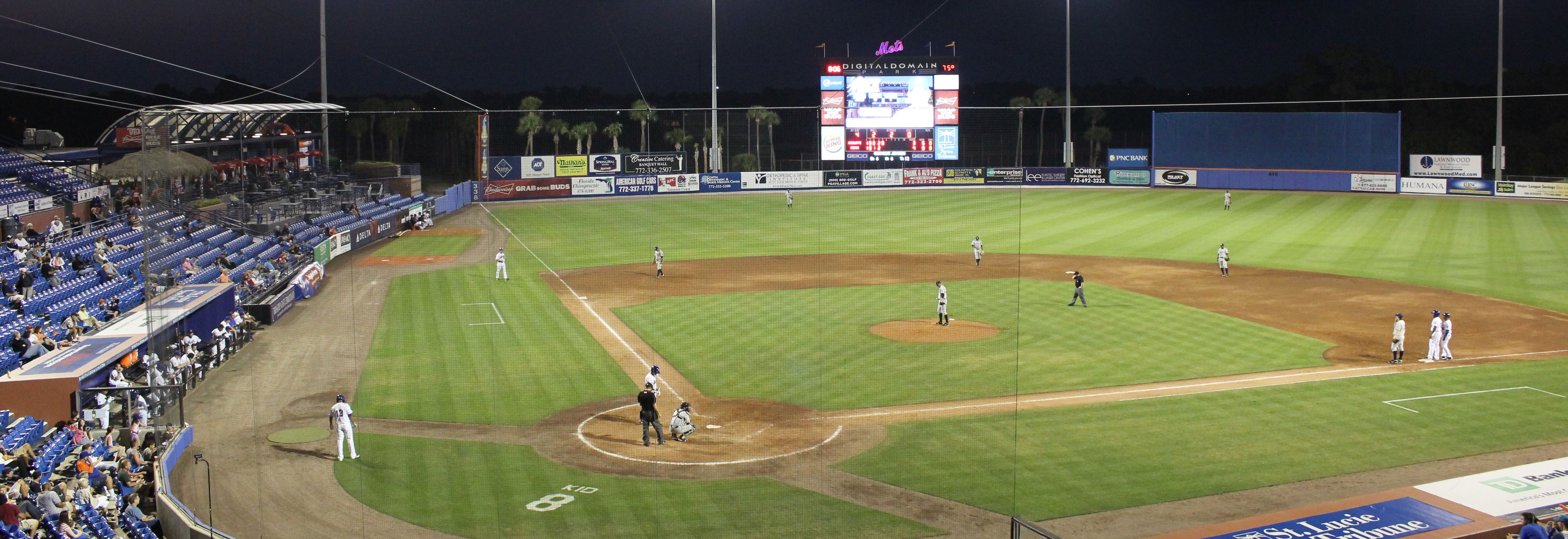BY CAROLYN LaWELL
PORT ST. LUCIE, Florida | Before the woods were cleared and thousand of houses went up, before I-95 stretched past here, before the dozens of chains like Holiday Inn and Ruby Tuesday moved in, Port St. Lucie was mainly uninhabited land, save for a fishing camp, cattle ranches and orange groves.
All of that changed after the New York Mets moved to town for spring training in 1988.
“This was nothing but a wooded area that was used for a little hunting, a little this, a little that,” says Tommy Bowes, the superintendent and head groundskeeper at Digital Domain Park, as he points toward the fields from a dugout a couple hours before the St. Lucie Mets, the Mets’ High-A affiliate, takes the field. Bowes has worked for St. Lucie County, situated near the middle of the state’s Atlantic Coast, since 1978. He grew the first blades of grass for the stadium and has been in charge of growing and grooming them ever since.
“Here’s how the whole thing started,” says Bowes. “A gentleman by the name of Mr. Thomas White out of St. Louis was a builder who had this dream of building schools and churches and homes in this area, but he wanted something to base it on. So he got with the county commissioners, and they went to the New York Mets and said, ‘We’ll build you a state-of-the art facility in a place called Port St. Lucie, all to your own. We’ll build you your fields and the stadium.’ That’s how it all got started.”
“We had Florida panthers, we had bobcats, we had wild hogs, so as we were clearing the land, we were constantly battling them coming in and tearing up the turf until we got all of the fences up." – Tommy Bowes
With the Mets on their way from St. Petersburg, where they shared a stadium with the St. Louis Cardinals, Bowes and his crew got busy knocking down trees and leveling the land. “One of the hardest jobs was to clear the wildlife that was here,” he says. “We had Florida panthers, we had bobcats, we had wild hogs, so as we were clearing the land, we were constantly battling them coming in and tearing up the turf until we got all of the fences up.
“As we progressed and the fields were being built, we had one place we could eat around here — that was on Bayshore — there was a little Dugout Diner, one gas station. And then we built the facility and the players came,” Bowes says. “When the players came, they said, ‘Well, what the heck are we going to do in a place called Port St. Lucie?’ They were all used to the nightlife. You had the 1986 world champion Mets coming here in 1988.”
Those teams were full of players like Ron Darling, Dwight Gooden and Darryl Strawberry, all of them used to bright lights and the high life, more than this new city could offer. Because Port St. Lucie and Queens are still like night and day, many of the players took up fishing. Today, players, and especially pitchers, pass their time with golfing, says Cory Mazzoni, a St. Lucie right hander.
Cory Vaughn, a St. Lucie outfielder, says the city may have grown over the years but it still has a small-town feel. Players jokingly call it Port St. Lonely.
St. Lucie West was advertised on billboards as a new town for the 21st century and the Mets were the attraction for families to relocate, for businesses to build. But, as Steven Crist wrote in a New York Times story in early 1988, it was a town that didn’t yet quite exist.
But once the Mets showed up, so did the people and the businesses.
“Now we have grown, and the area has grown around us,” Bowes says. “It’s great for the area and we’ve gotten bigger every year.”
To put the growth in perspective, Port St. Lucie’s population grew about 150 percent between 1990 — two years after the Mets moved in — and 2010, according to CLRSearch, a real estate search engine. The 2010 census listed the population at 164,603. Only eight cities in Florida are home to more people.
“A lot of cities were built around spring training ballparks,” says R.J. Palmer, a game day employee for the St. Lucie Mets since 2009. Palmer, 24, and his family moved from Ohio to Florida a decade ago. He started working with the old Vero Beach Dodgers and Vero Beach Rays at 16. After the Rays left Dodgertown, Palmer took a job with the Mets prior to the 2009 season.
During his time in Florida, Palmer has seen economic growth in other cities with Major League spring training and minor league teams, including Jupiter, home of the Hammerheads and the Palm Beach Cardinals, as well as Dunedin, home of the Blue Jays for more than 20 years.
Like many cities that flourished in the early 2000s, Port St. Lucie also experienced the reality of the housing bubble. As recently as September 2009, the county had the highest foreclosure rate in the state and, at one point, one of the higher foreclosure rates in the country. It has since decreased significantly, falling in February to 42nd of 67 counties in the state.
The city is still poised for continual growth. “Our area is going to boom,” Bowes says. “There’s talks about bringing a second team to our area, which we’re really excited about, and that will bring more restaurants, and more hotels, and more people. It’s been great.”
Carolyn@AMinorLeagueSeason.com ♦ @CarolynLaWell ♦ @AMinorLgSeason
Want to read stories about the other teams on our schedule? Click here and scroll to the calendar.
